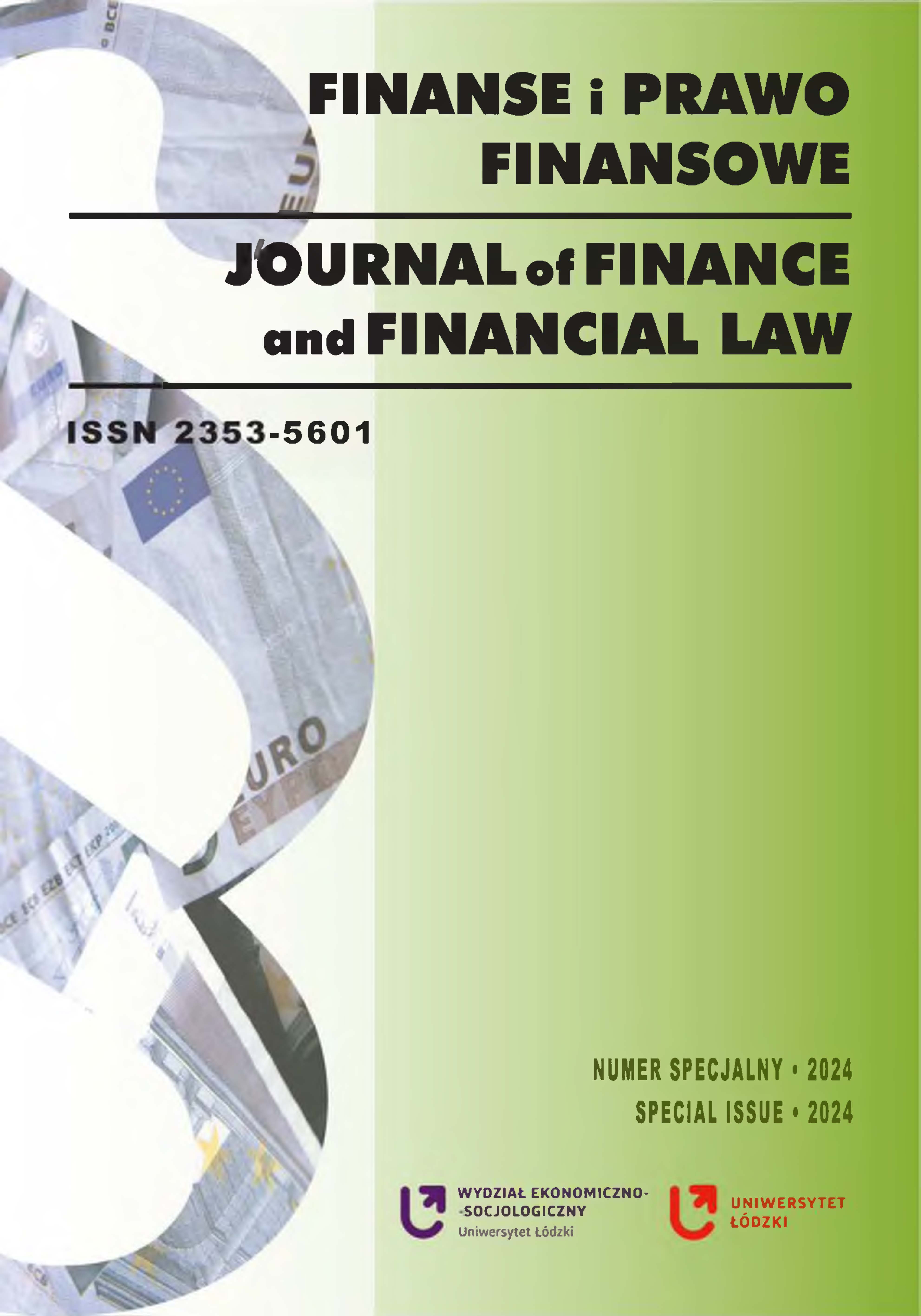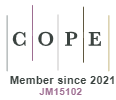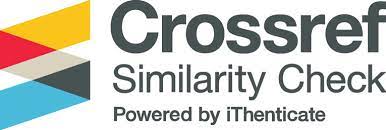Portfolio Management in Times of Elevated Risk. Safe-Haven and Hedge Assets in CAPM Setting
DOI:
https://doi.org/10.18778/2391-6478.S1.2024.03Keywords:
safe-haven assets, hedge, diversifier, CAPM, betaAbstract
The purpose of the article. The purpose of the article is to present the safe-haven concept according to the latest academic literature and distinguish it from the hedge and diversifier terms that are sometimes used interchangeably by researchers and portfolio managers. The ultimate goal of the paper is to place the safe-haven and hedge assets in the portfolio theory setting by introducing the negative beta parameter as stated in the Capital Asset Pricing Model. According to the literature, this article proposes a few approaches to identify and characterize safe-haven assets and to discover the perspective and outline further research in the portfolio theory.
Methodology. The work uses the method of descriptive and comparative analysis of literature, i.e., Systematic Literature Review (SLR). This method is used to present scientific overview of portfolio management when uncertainty rises to identify safe-haven and hedge assets.
Results of the research. This paper aims to characterize and identify three main types of assets helping investors to reduce the portfolio risk: safe haven, hedge, and diversifier. It introduces an improved analytical framework of beta parameter and drawdown beta concept to contribute to the rapidly expanding research on portfolio theory. Lastly it depicts a trade-off effect, which is stronger in-crisis performance of safe-haven assets. The returns of safe-haven assets are more positive when the stock market returns are more negative that may safeguard the financial system.
Downloads
References
Akhtaruzzaman, M., Boubaker, S., Lucey, B. M., and Sensoy, A. (2021). Is gold a hedge or a safe-haven asset in the COVID–19 crisis?. Economic Modelling, 102, pp. 105588. http://dx.doi.org/10.1016/j.econmod.2021.105588
Google Scholar
DOI: https://doi.org/10.1016/j.econmod.2021.105588
Azimli, A. (2022). Degree and structure of return dependence among commodities, energy stocks and international equity markets during the post-covid-19 period. Resources Policy, 77, pp. 102679. http://dx.doi.org/10.1016/j.resourpol.2022.102679
Google Scholar
DOI: https://doi.org/10.1016/j.resourpol.2022.102679
Baltensperger, E., Kugler, P. (2016). The historical origins of the safe haven status of the Swiss franc. Aussenwirtschaft, ISSN 0004-8216, Universität St.Gallen, Schweizerisches Institut für Aussenwirtschaft und Angewandte Wirtschaftsforschung (SIAW-HSG), St.Gallen, Vol. 67, Iss. 2, pp. 1–30.
Google Scholar
Batten, J.A., Ciner, C. and Lucey, B.M. (2010). The macroeconomic determinants of volatility in precious metals markets. Resources Policy, 35(2), pp. 65–71. http://dx.doi.org/10.1016/j.resourpol.2009.12.002
Google Scholar
DOI: https://doi.org/10.1016/j.resourpol.2009.12.002
Baur, D.G. and Lucey, B.M. (2009). Is gold a hedge or a safe haven? an analysis of stocks, bonds and gold. SSRN Electronic Journal [Preprint]. http://dx.doi.org/10.2139/ssrn.952289
Google Scholar
DOI: https://doi.org/10.2139/ssrn.952289
Baur, D.G. and McDermott, T.K. (2010). Is gold a safe haven? international evidence. Journal of Banking and Finance, 34(8), pp. 1886–1898. http://dx.doi.org/10.1016/j.jbank-fin.2009.12.008
Google Scholar
DOI: https://doi.org/10.1016/j.jbankfin.2009.12.008
Baur, D.G., Dimpfl, T. and Kuck, K. (2021). Safe haven assets - the bigger picture. SSRN Electronic Journal [Preprint]. http://dx.doi.org/10.2139/ssrn.3800872
Google Scholar
DOI: https://doi.org/10.2139/ssrn.3800872
Baur, Dirk G. and McDermott, Thomas K. J. (2013). Financial Turmoil and Safe Haven Assets. http://dx.doi.org/10.2139/ssrn.2004796
Google Scholar
DOI: https://doi.org/10.2139/ssrn.2004796
Bekiros, S., Boubaker, S., Nguyen, D. K., and Uddin, G. S. (2017). Black Swan events and safe havens: The role of gold in globally integrated emerging markets. Journal of International Money and Finance, 73, pp. 317–334. http://dx.doi.org/10.1016/j.jimonfin.2017.02.010
Google Scholar
DOI: https://doi.org/10.1016/j.jimonfin.2017.02.010
Bhuiyan, R.A., Husain, A. and Zhang, C. (2023). Diversification evidence of bitcoin and gold from wavelet analysis. Financial Innovation, 9(1). http://dx.doi.org/10.1186/s40854-023-00495-1
Google Scholar
DOI: https://doi.org/10.1186/s40854-023-00495-1
Bie, U., Henneberg Pedersen, A. (1999). The Role of Gold in the Monetary System. https://www.nationalbanken.dk/en/news-and-knowledge/publications-and-speeches/archive-publications/1999/the-role-of-gold-in-the-monetary-system [Accessed: 23.08.2024].
Google Scholar
Bogołębska, J., Feder-Sempach, E. and Stawasz-Grabowska, E. (2024). Safe assets in the global economy: Supply, demand and financial stability. Abingdon, Oxon: Routledge.
Google Scholar
DOI: https://doi.org/10.4324/9781003376538
Bogołębska, J., Feder-Sempach, E. and Stawasz-Grabowska, E. (2019). Reserve currency status as a safe asset determinant. Empirical evidence from main public issuers in the period 2005–2017. Comparative Economic Research. Central and Eastern Europe, 22(3), pp. 65–81. http://dx.doi.org/10.2478/cer-2019-0023
Google Scholar
DOI: https://doi.org/10.2478/cer-2019-0023
Boubaker, H., Cunado, J., Gil-Alana, L. A., and Gupta, R. (2020). Global crises and gold as a safe haven: Evidence from over seven and a half centuries of data. Physica A: Statistical Mechanics and its Applications, 540, pp. 123093. http://dx.doi.org/10.1016/j.physa.2019.123093
Google Scholar
DOI: https://doi.org/10.1016/j.physa.2019.123093
Bouri, E., Molnár, P., Azzi, G., Roubaud, D., and Hagfors, L. I. (2017). On the hedge and safe haven properties of bitcoin: Is it really more than a diversifier?. Finance Research Letters, 20, pp. 192–198. http://dx.doi.org/10.1016/j.frl.2016.09.025
Google Scholar
DOI: https://doi.org/10.1016/j.frl.2016.09.025
Bouri, E., Lucey, B. and Roubaud, D. (2020). The volatility surprise of leading cryptocurrencies: Transitory and permanent linkages. Finance Research Letters, 33, pp. 101188. http://dx.doi.org/10.1016/j.frl.2019.05.006
Google Scholar
DOI: https://doi.org/10.1016/j.frl.2019.05.006
Będowska-Sójka, B. and Kliber, A. (2021). Is there one safe-haven for various turbulences? The evidence from Gold, Bitcoin and Ether. The North American Journal of Economics and Finance, 56, pp. 101390. http://dx.doi.org/10.1016/j.najef.2021.101390
Google Scholar
DOI: https://doi.org/10.1016/j.najef.2021.101390
Changrong, L., Fandi, Y., Jiaxiang, L. and Shilong, L. (2024). Research on safe-haven currencies under global uncertainty — A new perception based on the East Asian market. Global Finance Journal, Volume 62, pp. 101013. https://doi.org/10.1016/j.gfj.2024.101013
Google Scholar
Chemkha, R., BenSaïda, A., Ghorbel, A. and Tayachi, T. (2021). Hedge and safe haven properties during COVID-19: Evidence from Bitcoin and gold. The Quarterly Review of Economics and Finance, Volume 82, pp. 71–85. https://doi.org/10.1016/j.qref.2021.07.006
Google Scholar
DOI: https://doi.org/10.1016/j.qref.2021.07.006
Choi, S., Shin, J. (2022). Bitcoin: An inflation hedge but not a safe haven. Finance Research Letters, Volume 46, Part B. https://doi.org/10.1016/j.frl.2021.102379
Google Scholar
DOI: https://doi.org/10.1016/j.frl.2021.102379
Cifarelli, G. and Paladino, G. (2015). A dynamic model of hedging and speculation in the Commodity Futures Markets. Journal of Financial Markets, 25, pp. 1–15. http://dx.doi.org/10.1016/j.finmar.2015.07.002
Google Scholar
DOI: https://doi.org/10.1016/j.finmar.2015.07.002
Connolly, R., Stivers, C. and Sun, L. (2005). Stock market uncertainty and the stock-bond return relation. Journal of Financial and Quantitative Analysis, 40(1), pp. 161–194. http://dx.doi.org/10.1017/s0022109000001782
Google Scholar
DOI: https://doi.org/10.1017/S0022109000001782
Coudert, V., Guillaumin, C., Raymond, H. (2014). Looking at the Other Side of Carry Trades: Are there any Safe Haven Currencies?. Working Papers 2014-03, CEPII research center.
Google Scholar
Ding, R. and Uryasev, S. (2022). Drawdown beta and portfolio optimization. Quantitative Finance, 22(7), pp. 1265–1276. http://dx.doi.org/10.1080/14697688.2022.2037698
Google Scholar
DOI: https://doi.org/10.1080/14697688.2022.2037698
Dębski, W., Feder-Sempach, E. and Świderski, B. (2016). Beta stability over bull and bear market on the Warsaw Stock Exchange. Folia Oeconomica Stetinensia, 16(1), pp. 75–92. http://dx.doi.org/10.1515/foli-2016-0006
Google Scholar
DOI: https://doi.org/10.1515/foli-2016-0006
Elton, E., Gruber, M. (1995). Modern Portfolio Theory and Investment Analysis, Fifth Edition. Wiley.
Google Scholar
Feder-Sempach, E., Szczepocki, P. (2022). The Bayesian Method in Estimating Polish and German Industry Betas. A Comparative Analysis of the Risk between the Main Economic Sectors from 2001–2020. Comparative Economic Research. Central and Eastern Europe, Volume 25, Number 2. https://doi.org/10.18778/1508-2008.25.12
Google Scholar
DOI: https://doi.org/10.18778/1508-2008.25.12
Feder-Sempach, E., Szczepocki, P. and Bogołębska, J. (2024). Global uncertainty and potential shelters: Gold, bitcoin, and currencies as weak and strong safe havens for Main World Stock Markets. Financial Innovation, 10(1). http://dx.doi.org/10.1186/s40854-023-00589-w
Google Scholar
DOI: https://doi.org/10.1186/s40854-023-00589-w
Gençyürek, A.G. and Ekinci, R. (2023). Safe-haven and hedging roles of precious metals for BRICS and Turkey. Borsa Istanbul Review, 23(2), pp. 297–321. http://dx.doi.org/10.1016/j.bir.2022.10.013
Google Scholar
DOI: https://doi.org/10.1016/j.bir.2022.10.013
Grisse, C. and Nitschka, T. (2015). On financial risk and the safe haven characteristics of Swiss Franc exchange rates. Journal of Empirical Finance, 32, pp. 153–164. http://dx.doi.org/10.1016/j.jempfin.2015.03.006
Google Scholar
DOI: https://doi.org/10.1016/j.jempfin.2015.03.006
Gronwald, M. (2019). Is Bitcoin a commodity? On price jumps, demand shocks, and certainty of supply. Journal of International Money and Finance, 97, pp. 86–92. http://dx.doi.org/10.1016/j.jimonfin.2019.06.006
Google Scholar
DOI: https://doi.org/10.1016/j.jimonfin.2019.06.006
Habib, M.M. and Stracca, L. (2012). Getting beyond carry trade: What makes a safe haven currency?. Journal of International Economics, 87(1), pp. 50–64. http://dx.doi.org/10.1016/j.jinteco.2011.12.005
Google Scholar
DOI: https://doi.org/10.1016/j.jinteco.2011.12.005
Hager, S.B. (2016). A global bond: Explaining the safe-haven status of US Treasury securities. European Journal of International Relations, 23(3), pp. 557–580. http://dx.doi.org/10.1177/1354066116657400
Google Scholar
DOI: https://doi.org/10.1177/1354066116657400
Jain, A. and Ghosh, S. (2013). Dynamics of global oil prices, exchange rate and precious metal prices in India. Resources Policy, 38(1), pp. 88–93. http://dx.doi.org/10.1016/j.resourpol.2012.10.001
Google Scholar
DOI: https://doi.org/10.1016/j.resourpol.2012.10.001
Kaczmarek, T., Będowska-Sójka, B., Grobelny, P. and Perez, K. (2022). False safe haven assets: Evidence from the target volatility strategy based on recurrent neural network. Research in International Business and Finance, 60, pp. 101610. http://dx.doi.org/10.1016/j.ribaf.2021.101610
Google Scholar
DOI: https://doi.org/10.1016/j.ribaf.2021.101610
Kaul, A. and Sapp, S. (2006). Y2K fears and safe haven trading of the U.S. dollar. Journal of International Money and Finance, Volume 25, Issue 5, pp. 760–779. https://doi.org/10.1016/j.jimonfin.2006.04.003
Google Scholar
DOI: https://doi.org/10.1016/j.jimonfin.2006.04.003
Lu, C., Yu, F., Li, J. and Li, S. (2024). Research on safe-haven currencies under global uncertainty - A new perception based on the East Asian market. Global Finance Journal, 62, pp. 101013. http://dx.doi.org/10.1016/j.gfj.2024.101013
Google Scholar
DOI: https://doi.org/10.1016/j.gfj.2024.101013
Lucey, B.M. and Li, S. (2015). What precious metals act as safe havens, and when? Some US evidence. Applied Economics Letters, 22(1), pp. 35–45. http://dx.doi.org/10.1080/13504851.2014.920471
Google Scholar
DOI: https://doi.org/10.1080/13504851.2014.920471
He, Z., O’Connor, F. and Thijssen, J. (2018). Is gold a sometime safe haven or an always hedge for equity investors? A Markov-switching CAPM approach for US and UK stock indices. International Review of Financial Analysis, 60, pp. 30–37. http://dx.doi.org/10.1016/j.irfa.2018.08.010
Google Scholar
DOI: https://doi.org/10.1016/j.irfa.2018.08.010
Shahzad, S.J. H., Bouri, E., Roubaud, D. and Kristoufek, L. (2020). Safe haven, hedge and diversification for G7 Stock Markets: Gold versus bitcoin. Economic Modelling, 87, pp. 212–224. https://doi.org/10.1016/j.econmod.2019.07.023
Google Scholar
DOI: https://doi.org/10.1016/j.econmod.2019.07.023
Lee, Z-Z., Su, C. and Tao, R. (2024). No longer a safe haven currency? A fresh evidence of Japanese yen under uncertainty. Panoeconomicus, 71(1), pp. 119–134. http://dx.doi.org/10.2298/pan190329021l
Google Scholar
Li, L. and Miu, P. (2023). Are cryptocurrencies a safe haven for stock investors? A regime-switching approach. Journal of Empirical Finance, 70, pp. 367–385. http://dx.doi.org/10.1016/j.jemp-fin.2022.12.010
Google Scholar
DOI: https://doi.org/10.1016/j.jempfin.2022.12.010
Markowitz, H. (1952). Portfolio Selection. The Journal of Finance, Vol. 7, No. 1, pp. 77-91.
Google Scholar
DOI: https://doi.org/10.1111/j.1540-6261.1952.tb01525.x
Masujima, Y. (2019). Time-variant safe-haven currency status and determinants. RIETI Discussion Paper Series.
Google Scholar
McCown, J.R. and Shaw, R. (2017). Investment potential and risk hedging characteristics of Platinum Group Metals. The Quarterly Review of Economics and Finance, 63, pp. 328–337. http://dx.doi.org/10.1016/j.qref.2016.06.001
Google Scholar
DOI: https://doi.org/10.1016/j.qref.2016.06.001
Miziołek, T., Feder-Sempach, E. and Zaremba, A. (2020). International Equity Exchange-traded funds: Navigating Global ETF Market Opportunities and risks. Cham: Palgrave Macmillan.
Google Scholar
DOI: https://doi.org/10.1007/978-3-030-53864-4
Mujtaba, G. G., Siddique, A., Naifar, N. and Shahzad, S. J. H. (2023). Hedge and safe haven role of commodities for the US and Chinese Equity Markets. International Journal of Finance and Economics, 29(2), pp. 2381–2414. http://dx.doi.org/10.1002/ijfe.2788
Google Scholar
DOI: https://doi.org/10.1002/ijfe.2788
O’Connor, F. A., Lucey, B. M., Batten, J. A., and Baur, D. G. (2015). The Financial Economics of Gold — A Survey. International Review of Financial Analysis, 41, pp. 186–205. http://dx.doi.org/10.1016/j.irfa.2015.07.005
Google Scholar
DOI: https://doi.org/10.1016/j.irfa.2015.07.005
Ranaldo, A. and Söderlind, P. (2009). Safe haven currencies. SSRN Electronic Journal [Preprint]. http://dx.doi.org/10.2139/ssrn.999382
Google Scholar
DOI: https://doi.org/10.2139/ssrn.999382
Raza, N., Ali, S., Shahzad, S. J. H., and Raza, S. A. (2018). Do commodities effectively hedge real estate risk? A multi-scale asymmetric DCC approach. Resources Policy, 57, pp. 10–29. http://dx.doi.org/10.1016/j.resourpol.2018.01.001
Google Scholar
DOI: https://doi.org/10.1016/j.resourpol.2018.01.001
Reilly, F., Brown, K. (1997). Investment Analysis and portfolio management. The Dryden Press. Fifth Ed.
Google Scholar
Rizvi, S.K., Naqvi, B., Mirza, N., and Umar, M. (2022). Safe haven properties of green, Islamic, and crypto assets and investor’s proclivity towards Treasury and gold. Energy Economics, 115, p. 106396. http://dx.doi.org/10.1016/j.eneco.2022.106396
Google Scholar
DOI: https://doi.org/10.1016/j.eneco.2022.106396
Shahzad, S.J., Bouri, E., Roubaud, D., Kristoufek, L., and Lucey, B. (2019). Is bitcoin a better safe-haven investment than gold and commodities?. International Review of Financial Analysis, 63, pp. 322–330. http://dx.doi.org/10.1016/j.irfa.2019.01.002
Google Scholar
DOI: https://doi.org/10.1016/j.irfa.2019.01.002
Sharpe, W. F. (1964). Capital-Asset Prices - a Theory of Market Equilibrium under Conditions of Risk. Journal of Finance, 19, pp. 425-442.
Google Scholar
DOI: https://doi.org/10.1111/j.1540-6261.1964.tb02865.x
Sikiru, A.A. and Salisu, A.A. (2021). Assessing the hedging potential of gold and other precious metals against uncertainty due to epidemics and pandemics. Quality and Quantity, 56(4), pp. 2199–2214. http://dx.doi.org/10.1007/s11135-021-01214-7
Google Scholar
DOI: https://doi.org/10.1007/s11135-021-01214-7
Smales, L.A. (2019). Bitcoin as a safe haven: Is it even worth considering?. Finance Research Letters, 30, pp. 385–393. http://dx.doi.org/10.1016/j.frl.2018.11.002
Google Scholar
DOI: https://doi.org/10.1016/j.frl.2018.11.002
Starr, M. and Tran, K. (2008). Determinants of the physical demand for gold: Evidence from panel data. Wiley Blackwell, vol. 31(3), pp. 416–436.
Google Scholar
DOI: https://doi.org/10.1111/j.1467-9701.2007.01091.x
Triki, M.B. and Ben Maatoug, A. (2021). The gold market as a safe haven against the stock market uncertainty: Evidence from geopolitical risk. Resources Policy, 70, pp. 101872. http://dx.doi.org/10.1016/j.resourpol.2020.101872
Google Scholar
DOI: https://doi.org/10.1016/j.resourpol.2020.101872
Tronzano, M. (2023). Safe-haven currencies as defensive assets in Global Stocks Portfolios: A reassessment of the empirical evidence (1999–2022). Journal of Risk and Financial Management, 16(5), pp. 273. http://dx.doi.org/10.3390/jrfm16050273
Google Scholar
DOI: https://doi.org/10.3390/jrfm16050273
Wang, Q., Wei, Y., Wang, Y., and Liu, Y. (2022). On the safe‐haven ability of bitcoin, gold, and commodities for international stock markets: Evidence from spillover index analysis. Discrete Dynamics in Nature and Society. http://dx.doi.org/10.1155/2022/9520486
Google Scholar
DOI: https://doi.org/10.1155/2022/9520486
Upper, C. (2000). How safe was the “safe haven”? Financial market liquidity during the 1998 Turbulences. SSRN Electronic Journal [Preprint]. http://dx.doi.org/10.2139/ssrn.2785107
Google Scholar
DOI: https://doi.org/10.2139/ssrn.219132
Vigne, S., Lucey, B. M., O’Connor, F. A., and Yarovaya, L. (2017). The financial economics of White Precious Metals - A Survey. SSRN Electronic Journal [Preprint]. http://dx.doi.org/10.2139/ssrn.2950207
Google Scholar
DOI: https://doi.org/10.2139/ssrn.2950207
Yan, Y., Lei, Y. and Wang, Y. (2022). Bitcoin as a safe-haven asset and a medium of exchange. Axioms, 11(8), pp. 415. http://dx.doi.org/10.3390/axioms11080415
Google Scholar
DOI: https://doi.org/10.3390/axioms11080415
Yousaf, I., Plakandaras, V., Bouri, E., and Gupta, R. (2023). Hedge and Safe-Haven Properties of FAANA against gold, US Treasury, Bitcoin, and US dollar/CHF during the pandemic period. The North American Journal of Economics and Finance, 64, pp. 101844. http://dx.doi.org/10.1016/j.najef.2022.101844
Google Scholar
DOI: https://doi.org/10.1016/j.najef.2022.101844
Zabarankin, M., Pavlikov, K. and Uryasev, S. (2014). Capital Asset Pricing Model (CAPM) with drawdown measure. European Journal of Operational Research, 234(2), pp. 508–517. http://dx.doi.org/10.1016/j.ejor.2013.03.024
Google Scholar
DOI: https://doi.org/10.1016/j.ejor.2013.03.024
Zheng-Zheng Li, Chi Wei Su and Ran Tao (2024). No Longer a Safe Haven Currency? A Fresh Evidence of Japanese Yen under Uncertainty. Panoeconomicus, Savez ekonomista Vojvodine, Novi Sad, Serbia, vol. 71(1), pp. 119–134.
Google Scholar
DOI: https://doi.org/10.2298/PAN190329021L
Downloads
Published
How to Cite
Issue
Section
License

This work is licensed under a Creative Commons Attribution-NonCommercial-NoDerivatives 4.0 International License.














